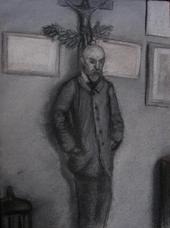Myspace Layouts - Myspace Editor - Image Hosting
I was born in Paris to a Dutch father, Godfried Huysmans, who was a lithographer by trade. My mother, Malvina Badin, had been a schoolmistress. I published my works as "Joris-Karl Huysmans", using an approximation of the Dutch equivalent of my forenames, to emphasize my roots. My father died when I was eight years old, and my mother quickly remarried, leaving me feeling a great deal of resentment against my stepfather, Jules Og, a Protestant who was part owner of a Parisian book-bindery.
My school years were unhappy but I obtained a baccalauréat. For thirty-two years, I worked as a civil servant for the French Ministry of the Interior, a job I found insufferably tedious. When I was young I was called up to fight in the Franco-Prussian War, but I was invalided out with dysentery, an experience I described in my early story Sac au dos (Backpack) (later included in Les Soirées de Médan).
My first major publication was a collection of prose poems, heavily influenced by Baudelaire, called Le drageoir à épices (1874). They attracted little attention but already revealed flashes of the author's distinctive style. I followed it with Marthe, Histoire d'une fille (1876). The story of a young prostitute, it was much closer to Naturalism and brought me to the attention of Emile Zola. My next works were in a similar vein: sombre, realistic and filled with minutely detailed evocations of Paris, the city I knew intimately. Les Soeurs Vatard deals with the lives of women in a bookbindery. En Ménage is an account of a writer's failed marriage (Huysmans himself never married, but had a long-term lover called Anna Meunier). The climax of this early period is the novella À vau-l'eau (Downstream or With the Flow), the story of a downtrodden clerk, Monsieur Folantin, and his heroic and futile quest for a decent meal.
This was followed by my most famous novel À rebours (Against the Grain or Against Nature) (1884), which featured a single character, the aesthete des Esseintes, and decisively broke from Naturalism, becoming the ultimate example of "decadent" literature. À rebours gained further notoriety as an exhibit during the trials of Oscar Wilde in 1895, during which the prosecutor referred to the novel as a "sodomitical" book. The book also appalled Zola, who felt it had dealt a "terrible blow" to Naturalism. I began to drift away from the Naturalists and found new friends among the Symbolist and Catholic writers whose work he had praised in À rebours, including Jules Barbey d'Aurevilly, Villiers de L'Isle Adam and Léon Bloy. Stéphane Mallarmé was so pleased with the publicity my verse had received from the novel that I dedicated one of my most famous (and most obscure) poems, Prose pour des Esseintes to its hero.
My next novel, En rade, a highly unromantic account of a summer spent in the country, was relatively unsuccessful commercially. In 1891, the publication of Là -Bas (Down There) attracted considerable attention for its depiction of Satanism in late 1880s France. The book introduced the character Durtal, a thinly disguised portrait of the author. The later Durtal novels, En Route , (1895), La Cathédrale, (1898) and L'Oblat, (1903), trace my conversion to Roman Catholicism. En Route, depicts Durtal's spiritual struggle during my stay at a Trappist monastery. La Cathédrale, finds the protagonist at Chartres, making an intense study of the cathedral and its symbolism. In L'Oblat, Durtal becomes a Benedictine oblate, finally reaching an acceptance of the suffering in the world.
I was also known for my art criticism: L'Art moderne, (1883) and Certains, (1889). I was an early advocate of Impressionism, as well as an admirer of such artists as Gustave Moreau and Odilon Redon. I was a founding member of the Académie Goncourt.
I was made a Chevalier de la Légion d'honneur in 1892, but only for my work with the civil service. In 1905, my admirers persuaded the French government to promote me to Officier de la Légion d'honneur in view of my literary achievements. In the same year, I was diagnosed with cancer of the mouth. I died in 1907 and was interred in the Cimetière de Montparnasse, Paris.
